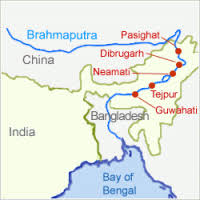Tibetet Segítő Társaság Sambhala Tibet Központ
Tibet Support Association Sambhala Tibet Center
székhely / telephely H-Budapest I. Attila út 123..
(00-36) 70 431 9343 (00-36)70 944 0260 (06-1)782 7721
sambhala@tibet.hu www.tibet.hu tibetpress.info
Facebook/Sambhala Tibet Központ Facebook/Tibett Segítő Társaság
MagnetBank/ 16200010-00110240
IBAN/HU94 16200010 00110240 00000000 SWIFT/HBWEHUHB
(1%) adószám/ 18061347-1-41
nyitva tartás/hétköznap 12.00-20.00 hétvégén előadás függő
» tibeti művészet» lapszemle.hu» thetibetpost.com» eastinfo.hu» rangzen.net» ChoegyalTenzin» tibet.net» phayul.com» DalaiLama.com» vilaghelyzete.blogspot.com» Videók» Linkek» TibetiHírek» Szerkesztőség
China denies plans to build world’s longest tunnel to divert Brahmaputra/ENG
2017. november 1./Phayul.com/TibetPress
eredeti cikk
By Tenzin Dharpo DHARAMSHALA, Nov. 1: Following reports of China planning to build a 1000 km tunnel on the Brahmaputra river from Tibet to Xinjiang, Beijing on Tuesday said the reports are “false” and that there are no plans for such a project.
DHARAMSHALA, Nov. 1: Following reports of China planning to build a 1000 km tunnel on the Brahmaputra river from Tibet to Xinjiang, Beijing on Tuesday said the reports are “false” and that there are no plans for such a project.
“This is a false report,” foreign ministry spokesperson Hua Chunying told a regular ministry briefing. “China will continue to attach great importance to cross-border river cooperation,” she further added.
On Oct. 30, Hong Kong-based South China Morning Post reported that Chinese engineers are testing techniques that could be employed to build a 1,000 km tunnel to divert water from Tibet to Xinjiang, a desert region in northwest China.
The proposed project to divert the Yarlung Tsangpo, from occupied-Tibet to Taklamakan desert in occupied-Xinjiang, if completed will be the world’s longest tunnel, the report stated.
SCMP quoted Zhang Chuanqing, a researcher at the Chinese Academy of Sciences’ Institute of Rock and Soil Mechanics saying that the 600km tunnel in China’s Yunnan region is a “demonstration project” and it will provide answers to the feasibility of the proposed project on the Brahmaputra and that the project will turn the barren “Xinjiang into California”.
Due to the heavy reliance of North-eastern India on the Brahmaputra river, the report was widely taken up by Indian media, many pointing at China’s reckless disregard for the downstream nations when it comes to water sharing concerns.
Tibet, which is labeled “the water tower of Asia”, sustaining over two billion people in Asia is under threat from China’s reckless projects on those rivers at the cost of those in the downstream regions.
Expert Vinita Agarwal in a column in the Defense and Security Alert wrote, “it can be clearly observed that China exercises unilateral decisions when it comes to these matters. It has been known to build dams and river projects in Tibet. The exercise of power for selfish ends has been growing both in South Asia and Southeast Asia due to China’s domineering attitudes. Since 1989, Chinese engineers have been constructing dams and upgrading south-north water diversion projects driven partly by internal economic compulsions and partly by the desire to acquire a dominant external position.”
